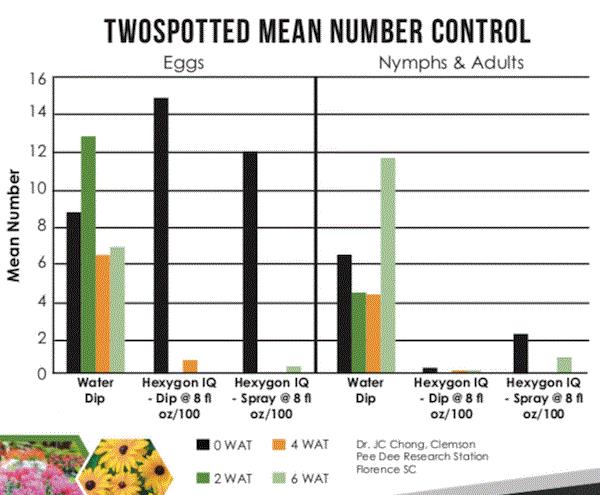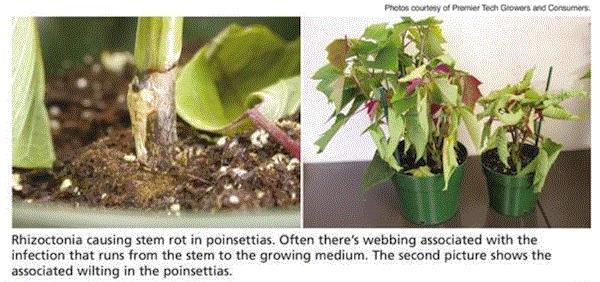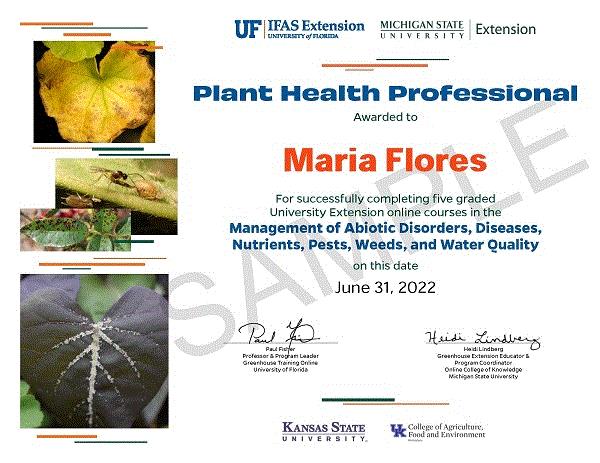Hexygon IQ for Pre-Plant Dip
I mentioned in the last issue, “A Special Garden Mum Edition,” that Hexygon can be used as a pre-plant dip of mum cuttings against spider mites. Several of you wrote in and told me that I'd never shared the news of that special use before.
I can’t believe I didn’t do that, especially when the recommendation was based on my research and I could gloat about it all day long!
The 2(ee) recommendation for bulb and cutting dip application of Hexygon IQ (hexythiazox) was issued in January 2022. Target pests are spider mites and the application rate is 0.08 fl. oz. per gallon. The recommendation is applicable to 23 states (including California and New York!). Click HERE to check if your state is included in this new 2(ee) recommendation.
I ran an experiment last year to determine if pre-plant dips with Hexygon IQ could be effective in killing spider mite eggs and nymphs on French marigold seedlings. I started by infesting each marigold seedling with five adult female spider mites, then removed all the spider mites after three days so that only eggs and nymphs (hatched from eggs) were left on the leaves. Hexygon is a mite growth regulator, so it’s only effective against eggs and nymphs. I designed this experiment to simulate the situation when seedlings and cuttings were infested with spider mite eggs and nymphs.
Next, I dipped the infested seedlings in water (as the untreated control), Hexygon IQ (at 0.04 and 0.08 fl. oz. per gallon) and 0.1% SuffOil-X. I also sprayed another group of infested marigold seedlings with Hexygon IQ at 8 fl. oz. per 100 gallons (the label rate). All treatments were applied one time. The dipped or sprayed seedlings were then transplanted individually in 6-in. standard plastic pots. I followed the growth of the spider mite population over the next six weeks. To prevent the mites from moving from the untreated plants to other treated and untreated plants, I placed a plastic saucer with water under each pot—kind of like moats for plants.

Here's what I found: While the numbers of eggs and motiles (a fancy name for nymphal and adult mites) stayed high on the untreated plants, there were almost no spider mites on plants dipped or sprayed with Hexygon IQ at 0.08 fl. oz. per gallon and dipped in SuffOil-X even after six weeks. Plants dipped in Hexygon IQ at 0.04 fl. oz. per gallon stayed clean up to four weeks after application. None of the plants showed any phytotoxic reaction to the treatments.
So there you have it—another tool in your "Start Clean, Stay Clean" program. This would be a good option if you have cuttings or seedlings infested with spider mite eggs and nymphs. If you also have adults, then you'll need to make additional foliar sprays with a miticide of different modes of action (hexythiazox beongs to IRAC Group 10A) to kill the adults and their offspring.
This research was originally conducted on marigold seedlings, but I think the result is applicable to other crops. Again, you should dip a small group of cuttings or seedlings to check for phytotoxicity before applying the treatment to all plants. The recommendation is applicable only in the United States. As far as I know, hexythiazox is not registered in Canada.

Common Root Diseases
I’m pretty confident that I know how to kill spider mites and other insects, but I often feel like I need more continuing education on diseases and weeds. I was glad to see an article, “Common Root Diseases,” in the July issue of GrowerTalks. The article is written by Nathan Wallace-Springer of Premier Tech Growers and Consumers, the producer of PRO-MIX growing media.
Nathan describes the symptoms and epidemiology of the most common root diseases, such as Pythium, Phytophthora, Rhizoctonia, black root rot and Fusarium. Symptoms of many diseases, especially root diseases, can be quite similar, so it’s important to have the diseases properly diagnosed by a diagnostic lab. Management approach varies among diseases. Disease diagnosis can mean saving or losing a crop.

Nathan also provided 10 tips to prevent and manage root diseases. One thing I want to remind everyone is not to overwater and over-fertilize. Over-fertilization stresses the roots and makes the plants more susceptible to root diseases. A plant suffering from Rhizoctonia infection will not perk up with extra water. In fact, overwatering will make root diseases worse.

Pace 49 Launches New Website
Pace 49, founded in Burnaby, British Colombia, in 1983, specialized in industrial boiler and water treatment. The company expanded into the horticultural industry in 1998, and into the United States and Mexico in 2004. Do you use KleenGrow or Strip-It Pro? Those are Pace 49’s products.

Pace 49 announced the launch of its Plant Health Advocates website. The redesigned website allows you to quickly search for disease management, water treatment or sanitation programs by categorizing contents under “Products” (such as KleenGrow and Strip-It Pro) or “Programs” (water enhancement, disease control and ACBD cleaning). (ACBD = Always clean before disinfecting.)
Visit Pace 49's new website HERE and visit them in-person at their booth (#1608) at Cultivate’22.
UF and MSU Collaborate on Online Training
Do you know the Greenhouse Training Online course from the University of Florida (UF) and the College of Knowledge from Michigan State University (MSU)? You'd probably heard of these two award-winning online training programs for greenhouse growers and pest managers. Over 4,000 participants have already graduated from various individual courses in these two programs.
It was announced on July 5 that the two programs will now collaborate. Growers who have completed five plant health courses in these two programs can now receive a new certificate of completion. The five courses can be selected from a list of six courses, which are:
-
Nutrient Management Level 1 (from UF)
-
Disease Management (from UF)
-
Weed Management (UF)
-
Water Quality and Treatment (UF)
-
Abiotic Disorders (MSU or University of Kentucky)
-
Biological Control (MSU or Kansas State University)
The first course in the series is Nutrient Management Level 1, which starts on July 11.

Those who are interested can sign up for individual courses at Greenhouse Training Online or the College of Knowledge websites.

A New USDA Grant Program Announced
The last piece of news today is something ... well, I’m not sure how directly it’s applicable to the green industry. When I first read the program name, I thought, “Well, USDA finally decided to put some real money behind biological products for pest management.” It turns out the program may be something more relevant to infrastructure and the environment.
USDA National Institute of Food and Agriculture (NIFA) announced on June 28 that the agency is soliciting proposals under a new competitive grant program, call the Bioproduct Pilot Program. (Let’s be D.C. and call this program the BPP.)
BPP will provide up to $10 million dollars in Fiscal Year 2022 and 2023 to support research programs that develop, scale up, and produce construction and consumer products from agricultural commodities (that is, bioproducts).
What are these “agricultural commodities,” you ask? Well, it sounds like it could be just about anything. The bioproducts should be cost-competitive, and with enhanced environmental and waste reduction benefits when compared to currently available materials or products. Some of us may be eligible for a grant under BPP if our products can be used for these purposes.
Individual grants range from $2 to $5 million dollars. Funds come from the currently passed Infrastructure Investment and Jobs Act (AKA the Infrastructure Bill). All higher education institutions (including land-grant universities, Hispanic-serving institutions, state institutions and State Agricultural Experiment Stations), Native American tribal organizations, non-profit organizations, small businesses and for-profit organizations are eligible to submit proposals.
Go HERE for more information on BPP. An informational webinar has been scheduled for July 14 from 2:00 to 3:30 p.m. Central Time. Go HERE to sign up.




See y'all later!

JC Chong
Professor of Entomology at Clemson University
This e-mail received by 27,318 subscribers like you!
If you're interested in advertising on PestTalks contact Kim Brown ASAP!